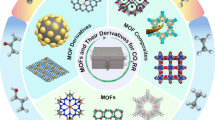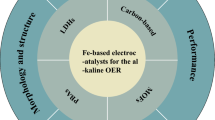Abstract
To achieve superior advanced oxidation processes (AOPs), transitional state activators are of great significance for the production of active radicals by H2O2, while instability limits their activation efficiency. In this study, density functional theory calculation (DFT) results showed that Cu+ exhibits excellent H2O2 activation performance, with Gibbs free energy change (ΔG) of 33.66 kcal/mol, two times less than that of Cu2+ (77.83 kcal/mol). Meanwhile, an electro-Fenton system using Cu plate as an anode was proposed for in situ generation of Cu+. The released Cu with low-valence state can be well-confined on the surface of the exciting electrode, which was confirmed by X-ray photoelectron spectroscopy (XPS), Raman, and UV-vis spectroscopy. The hydroxyl radicals in this Cu-based electro-Fenton system were determined by the electron spin resonance (ESR). The nitrobenzene degradation ratio was greatly increased by 43.90% with the introduction of the proposed in situ electrochemical Cu+ generation process. Various characterization results indicated that the production of Cu+ was the key factor in the highly efficient Cu-based electro-Fenton reaction.







Similar content being viewed by others
References
Ai Z, Xia H, Mei T, Liu J, Zhang L, Deng K, Qiu J (2008) Electro-Fenton degradation of Rhodamine B based on a composite cathode of Cu2O nanocubes and carbon nanotubes. J Phys Chem C 112:11929–11935
Bai J, Liu Y, Yin X, Duan H, Ma J (2017) Efficient removal of nitrobenzene by Fenton-like process with Co-Fe layered double hydroxide. Appl Surf Sci 416:45–50
Bañuelos JA, García-Rodríguez O, Rodríguez-Valadez FJ, Godínez LA (2015) Electrochemically prepared iron-modified activated carbon electrodes for their application in electro-Fenton and photoelectro-Fenton processes. J Electrochem Soc 162:E154–E159
Bokare AD, Choi W (2014) Review of iron-free Fenton-like systems for activating H2O2 in advanced oxidation processes. J Hazard Mater 275:121–135
Chen F, Zhao X, Liu H, Qu J (2014) Enhanced destruction of Cu(CN)3 2− by H2O2 under alkaline conditions in the presence of EDTA/pyrophosphate. Chem Eng J 253:478–485
Choi K, Lee W (2012) Enhanced degradation of trichloroethylene in nano-scale zero-valent iron Fenton system with Cu(II). J Hazard Mater 211-212:146–153
Chumakov A, Batalova V, Slizhov Y (2016) Electro-Fenton-like reactions of transition metal ions with electrogenerated hydrogen peroxide. Am Inst Phys 1772:040004
Costa RC, Lelis MF, Oliveira LC, Fabris JD, Ardisson JD, Rios RR, Silva CN, Lago RM (2006) Novel active heterogeneous Fenton system based on Fe3-xMxO4 (Fe, Co, Mn, Ni): the role of M2+ species on the reactivity towards H2O2 reactions. J Hazard Mater 129:171–178
Delley B (1990) An allelectron numerical method for solving the local density functional for polyatomic molecules. J Chem Phys 92:508–517
Delley B (2000) From molecules to solids with the DMol3 approach. J Chem Phys 113:7756–7764
Expósito E, Sánchez-Sánchez CM, Montiel V (2007) Mineral iron oxides as iron source in electro-Fenton and photoelectro-Fenton mineralization processes. J Electrochem Soc 154:E116–E122
Gabriel J, Shah V, Nesměrák K, Baldrian P, Nerud F (2000) Degradation of polycyclic aromatic hydrocarbons by the copper(II)-hydrogen peroxide system. Folia Microbiol 45:573–575
Gogate PR, Pandit AB (2004) A review of imperative technologies for wastewater treatment I: oxidation technologies at ambient conditions. Adv Environ Res 8:501–551
Guimaraes IR, Giroto A, Oliveira Luiz CA, Guerreiro MC, Lima DQ, Fabris JD (2009) Synthesis and thermal treatment of Cu-doped goethite: oxidation of quinoline through heterogeneous fenton process. Appl Catal B Environ 91:581–586
Hajimammadov R, Csendes Z, Ojakoski J-M, Lorite GS, Mohl M, Kordas K (2017) Nonlinear electronic transport and enhanced catalytic behavior caused by native oxides on Cu nanowires. Surf Sci 663:16–22
Hu Y, Li Y, He J, Liu T, Zhang K, Huang X, Kong L, Liu J (2018) EDTA-Fe(III) Fenton-like oxidation for the degradation of malachite green. J Environ Manag 226:256–263
Jiang J, Li G, Li Z, Zhang X, Zhang F (2016) An Fe–Mn binary oxide (FMBO) modified electrode for effective electrochemical advanced oxidation at neutral pH. Electrochim Acta 194:104–109
Khataee AR, Safarpour M, Zarei M, Aber S (2011) Electrochemical generation of H2O2 using immobilized carbon nanotubes on graphite electrode fed with air: investigation of operational parameters. J Electroanal Chem 659:63–68
Li CW, Kanan MW (2012) CO2 reduction at low overpotential on Cu electrodes resulting from the reduction of thick Cu2O films. J Am Chem Soc 134:7231–7234
Li Y, Zhou W, Wang H, Xie L, Liang Y, Wei F, Idrobo JC, Pennycook SJ, Dai H (2012) An oxygen reduction electrocatalyst based on carbon nanotube-graphene complexes. Nat Nanotechnol 7:394–400
Li Y, Liu L, Liu L, Liu Y, Zhang H, Han X (2016) Efficient oxidation of phenol by persulfate using manganite as a catalyst. J Mol Catal A Chem 411:264–271
Liao P, Keith JA, Carter EA (2012) Water oxidation on pure and doped hematite (0001) surfaces: prediction of Co and Ni as effective dopants for electrocatalysis. J Am Chem Soc 134:13296–13309
Magalhães F, Pereira MC, Botrel SEC, Fabris JD, Macedo WA, Mendonça R, Lago RM, Oliveira LCA (2007) Cr-containing magnetites Fe3−xCrxO4: the role of Cr3+ and Fe2+ on the stability and reactivity towards H2O2 reactions. Appl Catal A Gen 332:115–123
Moreira AH, Benedetti AV, Cabot PL, Sumodjo TA (1993) Electrochemical behaviour of copper electrode in concentrated sulfuric acid solutions. Electrochim Acta 38:981–987
Moreira FC, Boaventura RAR, Brillas E, VJP V (2017) Electrochemical advanced oxidation processes: a review on their application to synthetic and real wastewaters. Appl Catal B Environ 202:217–262
Nguyen DCT, Oh WC (2018) Ternary self-assembly method of mesoporous silica and Cu2O combined graphene composite by nonionic surfactant and photocatalytic degradation of cationic-anionic dye pollutants. Sep Purif Technol 190:77–89
Nidheesh PV, Gandhimathi R (2014) Effect of solution pH on the performance of three electrolytic advanced oxidation processes for the treatment of textile wastewater and sludge characteristics. RSC Adv 4:27946
Nie Y, Hu C, Qu J, Zhao X (2009) Photoassisted degradation of endocrine disruptors over CuOx–FeOOH with H2O2 at neutral pH. Appl Catal B Environ 87:30–36
Peng J, Li J, Shi H, Wang Z, Gao S (2016) Oxidation of disinfectants with Cl-substituted structure by a Fenton-like system Cu2+/H2O2 and analysis on their structure-reactivity relationship. Environ Sci Pollut Res 23:1898–1904
Pérez-Moya M, Graells M, Buenestado P, Mansilla HD (2008) A comparative study on the empirical modeling of photo-Fenton treatment process performance. Appl Catal B Environ 84:313–323
Pignatello JJ, Oliveros E, MacKay A (2006) Advanced oxidation processes for organic contaminant destruction based on the Fenton reaction and related chemistry. Crit Rev Environ Sci Technol 36:1–84
Ramirez-Pereda B, Alvarez-Gallegos A, Rangel-Peraza JG, Bustos-Terrones YA (2018) Kinetics of Acid Orange 7 oxidation by using carbon fiber and reticulated vitreous carbon in an electro-Fenton process. J Environ Manag 213:279–287
Razgoniaev AO, McCusker CE, Castellano FN, Ostrowski AD (2017) Restricted photoinduced conformational change in the Cu(I) complex for sensing mechanical properties. ACS Macro Lett 6:920–924
Robbins M, Drago RS (1997) Activation of hydrogen peroxide for oxidation by copper(II) complexes. J Catal 170:295–303
Salem IA (2000) Kinetics of the oxidative color removal and degradation of bromophenol blue with hydrogen peroxide catalyzed by copper(II)-supported alumina and zirconia. Appl Catal B Environ 28:153–162
Santana-Martínez G, Roa-Morales G, Martin del Campo E, Romero R, Frontana-Uribe BA, Natividad R (2016) Electro-Fenton and electro-Fenton-like with in situ electrogeneration of H2O2 and catalyst applied to 4-chlorophenol mineralization. Electrochim Acta 195:246–256
Silva AC, Oliveira DQL, Oliveira LCA, Anastácio AS, Ramalho TC, Lopes JH, Carvalho HWP, Torres CER (2009) Nb-containing hematites Fe2−xNbxO3: the role of Nb5+ on the reactivity in presence of the H2O2 or ultraviolet light. Appl Catal A Gen 357:79–84
Singh A, Verma A, Bansal P, Singla J (2017) Evaluation of the process parameters for electro Fenton and electro chlorination treatment of Reactive Black 5 (RB5) dye. J Electrochem Soc 164:E203–E212
Tahir D, Tougaard S (2012) Electronic and optical properties of Cu, CuO and Cu2O studied by electron spectroscopy. J Phys Condens Matter 24:175002
Verma P, Baldrian P, Gabriel J, Trnka T, Nerud F (2004) Copper–ligand complex for the decolorization of synthetic dyes. Chemosphere 57:1207–1211
Wang A, Cheng H, Liang B, Ren N, Cui D, Lin N, Kim BH, Rabaey K (2011) Efficient reduction of nitrobenzene to aniline with a biocatalyzed cathode. Environ Sci Technol 45:10186–10193
Wang J, Liu C, Tong L, Li J, Luo R, Qi J, Li Y, Wang L (2015) Iron–copper bimetallic nanoparticles supported on hollow mesoporous silica spheres: an effective heterogeneous Fenton catalyst for orange II degradation. RSC Adv 5:69593–69605
Wang Y, Ji Z, Shen X, Zhu G, Wang J, Yue X (2017) Facile growth of Cu2O hollow cubes on reduced graphene oxide with remarkable electrocatalytic performance for non-enzymatic glucose detection. New J Chem 41:9223–9229
Wang Y, Xue Y, Zhang C (2019) Enhanced anodic dissolution of cupronickel alloy scraps by electro-generated reactive oxygen species in acid media. J Alloys Compd 806:106–112
Xu X, Liao P, Yuan S, Tong M, Luo M, Xie W (2013) Cu-catalytic generation of reactive oxidizing species from H2 and O2 produced by water electrolysis for electro-fenton degradation of organic contaminants. Chem Eng J 233:117–123
Xue Y, Jin W, Du H, Zheng S, Sun Z, Yan W, Zhang Y (2016) Electrochemical Cr(III) oxidation and mobilization by in situ generated reactive oxygen species in alkaline solution. J Electrochem Soc 163:H684–H689
Xue Y, Zhang Y, Zhang Y, Zheng S, Zhang Y, Jin W (2017a) Electrochemical detoxification and recovery of spent SCR catalyst by in-situ generated reactive oxygen species in alkaline media. Chem Eng J 325:544–553
Xue Y, Zheng S, Du H, Zhang Y, Jin W (2017b) Cr(III)-induced electrochemical advanced oxidation processes for the V2O3 dissolution in alkaline media. Chem Eng J 307:518–525
Xue Y, Zheng S, Sun Z, Zhang Y, Jin W (2017c) Alkaline electrochemical advanced oxidation process for chromium oxidation at graphitized multi-walled carbon nanotubes. Chemosphere 183:156–163
Yang S, He H, Wu D, Chen D, Liang X, Qin Z, Fan M, Zhu J, Yuan P (2009) Decolorization of methylene blue by heterogeneous Fenton reaction using Fe3−xTixO4 (0 ≤ x ≤ 0.78) at neutral pH values. Appl Catal B Environ 89:527–535
Zhang G, Gao Y, Zhang Y, Guo Y (2010) Fe2O3-pillared rectorite as an efficient andstable Fenton-like heterogeneous catalyst for photodegradation of organiccontaminants. Environ Sci Technol 44:6384–6389
Zhang G, Wang S, Zhao S, Fu L, Chen G, Yang F (2011) Oxidative degradation of azo dye by hydrogen peroxide electrogenerated in situ on anthraquinonemonosulphonate/polypyrrole composite cathode with heterogeneous CuO/γ-Al2O3 catalyst. Appl Catal B Environ 106:370–378
Zhang L, Nie Y, Hu C, Qu J (2012) Enhanced Fenton degradation of Rhodamine B over nanoscaled Cu-doped LaTiO3 perovskite. Appl Catal B Environ 125:418–424
Zhang Q, Liu Y, Chen S, Quan X, Yu H (2014) Nitrogen-doped diamond electrode shows high performance for electrochemical reduction of nitrobenzene. J Hazard Mater 265:185–190
Zhao L, Ma J, Sun Z (2008) Oxidation products and pathway of ceramic honeycomb-catalyzed ozonation for the degradation of nitrobenzene in aqueous solution. Appl Catal B Environ 79:244–253
Funding
This research was financially supported by the Research Fund of Major Science and Technology Program for Water Pollution Control and Treatment (2017ZX07402001).
Author information
Authors and Affiliations
Corresponding authors
Additional information
Responsible editor: Vítor Pais Vilar
Publisher’s note
Springer Nature remains neutral with regard to jurisdictional claims in published maps and institutional affiliations.
Electronic supplementary material
ESM 1
(PDF 372 kb)
Rights and permissions
About this article
Cite this article
Wang, Y., Zhang, G., Xue, Y. et al. In situ anodic induction of low-valence copper in electro-Fenton system for effective nitrobenzene degradation. Environ Sci Pollut Res 26, 32165–32174 (2019). https://doi.org/10.1007/s11356-019-06387-1
Received:
Accepted:
Published:
Issue Date:
DOI: https://doi.org/10.1007/s11356-019-06387-1




